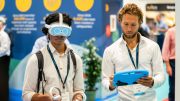For many healthcare providers the last 12-months have seen rapid transformations in technology-led care provision, necessitated by the need to offer digital-first care solutions. Questions are now shifting towards the future and how healthcare will continue to change as we move beyond the restrictions of the COVID-19 pandemic.
Here Diana Nole, EVP and GM of Nuance’s Healthcare division shares her perspectives on what we can expect.
1. What were the key technological breakthroughs that helped healthcare organisations to continue with ‘business as usual’ during the pandemic?
The biggest breakthrough allowing organisations to continue with ‘business as usual’ during the pandemic has been the speed at which healthcare has embraced technology as an enabler. The pandemic forced a cultural shift within the NHS that has been envisioned for a long time, but many organisational structures and barriers prevented it from becoming a reality.
One of the major immediate changes we saw was patients and providers increasingly turning to telehealth for routine and non-urgent care. Pre-pandemic, just 10% of patients took advantage of telehealth in lieu of an in-person visit – but that has changed rapidly before our eyes. So many of us were told to stay home, to work from home, to shelter in place. Following these guidelines meant shifting more and more of our interactions to digital platforms as often as practical and appropriate.
Moving forward, accelerated adoption of telehealth technologies means new healthcare experiences for patients and providers alike. From an efficiency perspective, there are time savings to be had. Patients no longer need to drive back and forth to appointments and follow-ups, allowing for time back in their day. For doctors with the right technologies and resources in place, patient care can still be delivered quickly and efficiently, allowing doctors to complete their work faster and get home to loved ones.
2. How have technology companies responded to the increased demand for new and updated solutions?
Technology companies have largely rallied together in order to give the NHS what it needs to tackle the pandemic. Organisations like Microsoft, for example, have supported care teams with analytics functions to predict where ventilators, hospital beds, and medical staff will be most in need.
During the pandemic, at Nuance, we provided a free COVID-19 content pack for all users of our healthcare platform in the UK. Developed by and for clinicians, the offer aims to provide structured templates to support clinicians with their documentation process – using their voices to complete patient records without having to remove their PPE. This safeguards both employees and patients as they complete critical documentation processes and assures the severity of the COVID case is captured.
3. What needs to happen in your opinion to ensure that innovation and the use of technology continues now the restrictions are being lifted?
There’s been a lot of talk of ‘the new normal’. The new normal for the NHS – other than the donning of facemasks in public places and calls for frequent handwashing – will be the continued spike in virtual doctor visits. The millions of GP appointments that take place each month are now by video – and this doesn’t appear as though it will change.
Recently, speaking at a meeting of the Royal College of Physicians, Health Secretary Matt Hancock said, “From now on, all consultations should be tele-consultations unless there’s a compelling clinical reason not to.” This ‘new normal’ does, however, require some learning on the part of patients, and clinicians, about the various challenges of this growing trend in healthcare. For example, understanding the security, privacy, etiquette, and perhaps more importantly, the documentation of the interaction.
As more virtual visits take place and physical examination and intervention obligate to the new format, many doctors lament at the challenge of capturing the patient’s story. In essence, a 10-to-15-minute conversation via a telehealth platform could encompass some 1,500 words or three pages of single-spaced text. Some doctors have complained that using standard EHR tools to document visits can take hours of their day and may miss pertinent details. This is where technology such as speech recognition, when incorporated into a doctor’s routine following a consultation, can play a critical role in significantly cutting that administrative burden.
4. How do you think the pandemic will impact the use of healthcare technology moving forward?
We’re going to see an increase in the consumerisation of healthcare as a result of the pandemic. The expectations we have all developed as digital consumers are now clearly mapping onto how we think about our own healthcare, the services we receive, and how we engage with the NHS or private healthcare providers.
Patients are looking for more transparency on treatments, wait times and clinical outcomes. The faster that technology innovators can increase transparency and engagement and make healthcare IT more user-friendly for doctors and patients alike, the faster we can alleviate the strains and frustrations, elevate trust, and improve quality of care for patients.
The Hippocratic Oath calls on doctors to do everything in their power to care for patients. It reminds them that medicine is an art as well as a science, and that warmth, sympathy and understanding can be as or even more important than procedures or prescriptions. The Oath also explicitly states the importance of patient privacy. It’s incumbent on us as technology leaders and innovators to make the same level of commitment to physicians and their patients with solutions that are technically superior, that prioritise the human elements of healthcare, and that have clear, demonstrable mechanisms for privacy protection and informed consent. If this is the outcome for the NHS and broader healthcare providers as we begin to exit the COVID-19 crisis, it’ll be a significant step in our progress moving forward.





